| General Interest |
|---|
| 30 Years and Counting |
| Where Have 30 Years Gone? |
| How to Get a Job at a Marcom Agency |
| How the StratAmp Team has Made Remote Working Work |
Evolving Media Ecosystem:
The Value of Micro-Communities and Targeted Storytelling
Miles Pollock, Partner, StrategicAmpersand Inc.
April 17, 2025

The media landscape has never been more fragmented or rife with opportunities. For B2B marketers, finding the right audience in this crowded environment involves more than chasing headlines and counting clicks, although those things remain important. But today, building meaningful connections with prospects, partners, journalists and industry influencers requires adapting to the rapid shift toward niche communities where trust and relevance reign.
Industry research increasingly shows that today’s B2B buyers place a high premium on peer reviews, social proof, and authoritative industry news/information sources and content before making purchase decisions. This reflects an evolving landscape: while brand recognition remains critically important, truly effective engagement depends on targeted storytelling and messaging that speaks directly to well-defined, specialized audiences.
The Rise of Closely-Targeted Micro-Communities in B2B
In B2C circles, micro-communities – tight-knit groups built around shared interests – have been a key element of marketing strategies for some time. Yet there’s immense potential for B2B organizations to increasingly harness such focused target groups. Whether it’s a LinkedIn group of IT professionals, an online Reddit forum dedicated to supply chain optimization, followers of a key IT journalist, attendees at an industry trade show, or a Slack channel discussing the latest in fintech, B2B decision-makers rely on trusted peers and industry experts to validate products, solutions or services.
We know, through lengthy experience, how targeted storytelling can spark authentic engagement in specialized communities of prospects. When you speak the language of your core audience, and address the issues they care about, the message resonates far beyond traditional marketing channels.
Influencer Engagement is an Effective B2B Strategy Too
‘Influencers’ may often bring to mind lifestyle bloggers or Instagram personalities. However, B2B influencer engagement is about hearing and learning from thought leaders, journalists, sector analysts and trusted experts, all of whom shape industry conversations.
StrategicAmpersand partners with clients to identify the right influencers – those who aren’t necessarily internet-famous, but hold sway over an industry’s most relevant audiences in important ways. By co-developing webinars, panel discussions, valuable content like blogs and white papers, and more, we help our clients tap into the established credibility of these thought leaders, ensuring brand/product/solution messages and launches gain traction with the right people.
Targeted Digital Advertising Ensures Reach of the Right Audiences
Even the most compelling advertising message needs to reach the right set of eyes. That’s why B2B digital ad spending has continued its steady rise year-over-year, underlining the effectiveness of hyper-targeted campaigns. In B2B, where decisions often involve multiple stakeholders, that kind of precision is crucial.
The StrategicAmpersand advertising team relies heavily on data-driven paid digital advertising strategies that pinpoint closely-targeted audiences. From programmatic ad planning and buying to LinkedIn-specific targeting to custom-tailored remarketing campaigns, we deploy advanced technologies and analytics to ensure each dollar spent aligns with our clients’ specific goals – whether that means introducing new products/solutions, generating leads, driving downloads of a content asset, securing registrations for a webinar, reaching trade show attendees, or other objectives. By focusing on platforms and channels where niche audiences are most active, we help our clients’ brands, products and solutions rise above the clutter.
Our synergistic approach, combining PR programs with closely-targeted ad strategies, amplifies messages across relevant micro-communities. Working in lockstep with our clients’ broader communications plans, digital advertising becomes a potent lever for targeted storytelling, reinforcing key messages, underscoring unique value propositions, and driving prospects to valuable content.
Tailoring the Message – Proof Over Promises
B2B marketing isn’t necessarily about casting a wide net to catch as many eyeballs as possible; it’s just as often about speaking directly to the individuals who truly influence buying decisions. For instance, if you’re selling advanced manufacturing software, your audience may consist of plant managers and operations leaders who value efficiency and measurable ROI. Crafting content that addresses these specific priorities – backed by data, case studies, and clear evidence of performance – can deliver significantly better engagement than broad, one-size-fits-all product or solution campaigns.
In our era of information overload, demonstrating tangible results is the surest way to earn trust. In fact, Gartner suggests that over 80% of B2B buyers prefer digital interactions due to convenience, yet trust remains a critical deciding factor. That’s why we place such importance on evidence-based communications – proof over promises. Through tactics like data-backed press releases, tailored success stories, precisely targeted digital advertising and more, we help organizations transform customer successes and insightful facts into compelling narratives that bring measurable value to potential customers.
Stand Out With Targeted Storytelling
The media landscape will continue to evolve, but the fundamental truth is this – people want credible information and genuine connections. Whether your goal is to increase brand awareness, generate qualified leads or expand into a new market segment, targeted storytelling – reinforced by similarly-targeted digital advertising – remains a powerful combination. By focusing on micro-communities, enlisting credible influencers and backing up your claims with solid proof, your B2B organization can stand out in an increasingly crowded digital arena.
At StrategicAmpersand, we understand that every organization has unique needs. Through our integrated Public Relations, Advertising, and Brand Communication services, we help clients forge meaningful, long-lasting relationships – one micro-community at a time.
De-Generative AI – The Creative Death Valley?
By Illya Noble (ME/HE), Senior Art Director, StrategicAmpersand
September 5, 2024
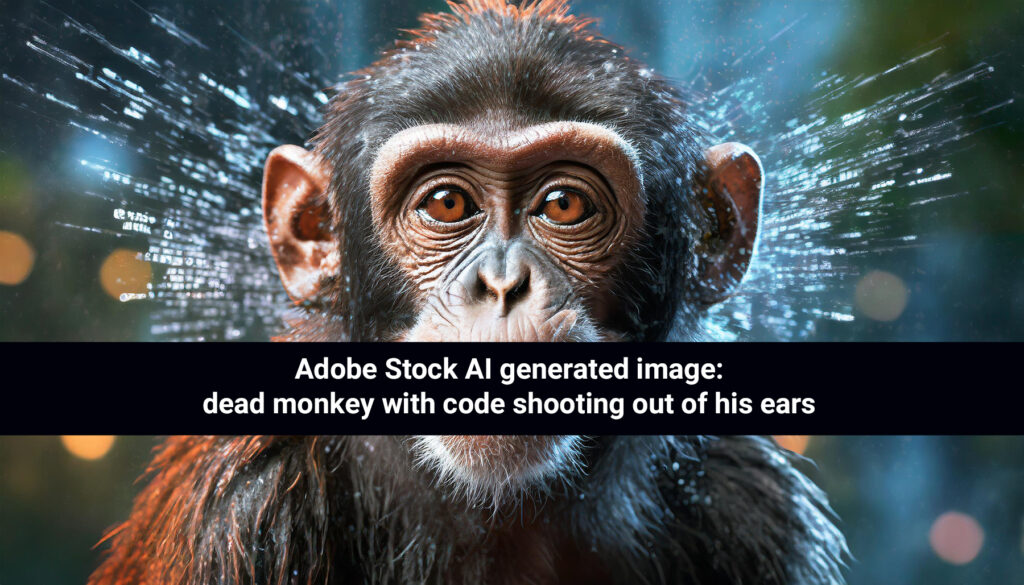
I’m writing this with some fine death metal music playing, not quite in the background. No, that’s not ALL I listen to!
Thank you programmers, financiers and worldly scum (99.9999999999% men) it wasn’t enough that you created online pornography and gambling, gaming, dating apps, streaming music, movies and shows, you’ve now taken us into the deadly rabbit hole of AI generated advertising creative including imagery, illustration, layout, as well as music, and writing of course (gee thanks ChatGPT!).
Yes, of course there are some positives for mankind and the creative soul in some of the technological advances above, but frankly in my opinion, AI is just another step in the squashing of the original, imaginative, human, creative spirit and the artists that create.
Here’s a comparison: I recall early in my career, maybe in the early 90s, a client came through the creative studio where I was working on the Mac. While glancing over my shoulder as I worked on a layout in Quark Express he said, “Even a monkey could do it”. Maybe my layout was too basic, or maybe he was implying the technology was doing all the work for me. I’ll go with the latter!
What the technology did do, was make it easier for anyone who wasn’t an artist, to make changes and have more creative input. We said farewell to the labour-heavy glory days of advertising – think Madmen through the 70’s, when the art director and writer came up with the ideas and saw them through with a paste-up artist, typesetter, stat machine, film stripper (I said film) and printer, and of course the advent of tv which was created to sell products. Ahh, there I said it. Selllllll! I forgot it’s ‘commercial art’.
As traditional commercial artists back then, we had to adapt to the new technology of creating art on a computer; some of us did and many did not. I believe something similar is happening now with this revolution in creative technology, specifically generative AI, as being introduced by Adobe who has a virtual world monopoly on creative software. What we are seeing again, is the proliferation of non-artists to control the creative product by making it easier for them to have greater input into the final outcomes with more and more homogeneous, safe, and not necessarily creative or original outputs because they are based on repositories of existing content and algorithms.
Here’s the chorus from the song ‘Everything is free’ from a Father John Misty song (not death metal) that illustrates the plight of the artist, musical or any other creative discipline really:
Everything is free
That’s what they say
Everything I ever done
Gotta give it away
Someone hit the big score
They figured it out
That we’re gonna do it anyway
Even if it doesn’t pay
by ‘Father John Misty’
From the beginning until the end of time, the artist will always be taken advantage of, used, underpaid and discarded. Most of them just don’t have the savvy to take care of the financial side of things and can’t write code, even if all they did before helped create the algorithms that will dictate future creative. We are not built for it – we are creative, imaginative and dreamy and see life from the other side.
Yes, I understand you need both sides in ‘commercial’ art. Luckily there are those business partners along the way (like my colleagues) who recognize the value of, and the need for the artist, and share in the success that art and business can achieve together. Though I admit you programmers out there are more important than ever; that’s good – we need people with all the different acumens working together.
I was ranting negatively about AI in the hockey locker room a few weeks back, and one of my buds (he’s in sales) said, “Maybe the programmers are now the creatives”. Damn, I hope not, or I’m screwed.
I’m still standing (yeah yeah yeah). Thanks Elton John! (not death metal).
30 Years and Counting
By Illya Noble, Senior Art Director, StrategicAmpersand
May 23, 2024

When I started my creative design and art direction career in 1987, I spent 10 months at my first gig working full-time at an agency that was happy to have me log 60-80 hours a week. I had no problem paying my dues and doing the time, but then my 9 month review came and after getting glowing reviews they thought it best I did not get the raise they had promised because I was occasionally late 5 minutes in the am. I’ve never been a great morning person!
Everyone else without fail, left at 5 every day, yet I was expected to do all the extra design work and stay late most nights without compensation. They were paying me less than minimum wage at the time, so after learning about freelance agencies and meeting some other artists I decided that was the design life for me.
I vowed never to work full-time for anyone again!
So I started off on my freelance journey and after about 5 years gaining experience, learning the mac and the early design software I had a placement at an oddly named agency; StrategicAmpersand Inc. It was a new partnership formed by the heads of two smaller firms, those new partners being Gayle Robin and Miles Pollock. They had decided to form a new integrated agency specializing in the technology industry.
After freelancing for StrategicAmpersand off and on since 1992 and repeated offers to work with them full-time, I finally agreed in 1994 to take the plunge. The partners asked me what I wanted and I thought I gave them an offer they had to refuse. To my shock and awe they agreed without hesitation.
Turns out, it was the best career decision of my life.
I was given autonomy to help build the creative department, all the resources required, new hires to support the rapidly increasing business and great creative work space to function in peace when necessary. They trusted me to get things done, meet deadlines and always compensated well. There were legendary parties, great lunches, company outings, paid professional development, flexible hours, work from home, bonuses, etc.
And they put up with a creative lunatic, the rants and colourful language! I won’t mention the busted sprinkler head from an errantly thrown football that emptied all the systems’ water in the middle of the creative department. Those sprinkler heads need to be built better!
Well it’s 2024 and I just celebrated 30 years full-time with Gayle and Miles and the rest of the team at SA and just wanted to say thanks for everything and I’m not done until the virtual doors close on my writhing limbs and faint distant wails!
A Look Back: 25 Years

By Anita Wong, Vice President of Public Relations
April 29, 2024
When I started my career in communications, the managing partner at my first PR agency said that we, as PR consultants, should stay behind the scenes. Save the spotlight for our clients. While times have changed, that advice has stuck with me.
I was asked to write a post reflecting on my last 25 years with StrategicAmpersand (StratAmp for short). My immediate thoughts were of the memorable projects we have had the privilege to work on for our clients. They are remarkable to me because of the people involved along the way: the clients who put their trust in us, my colleagues who brought their diverse skills, the journalists who gave us the ability to share our stories, the people who were featured because of their contributions, or – in some cases – all of the above.
These are some of my most poignant memories of clients, people and projects along the way.
Novell BrainShare
This is number one on my list because Novell was my first client at StratAmp. I still miss working with Mike Levy (a mentor), Don Chapman, Ross Chevalier, Lisa Williams, Jeff Hayward, Steve Barber and Penny Triberio. They were wise, kind, open and collaborative. Special thanks must go to Debbi Crossen who pointed me towards B2B technology and Karin Scott who hired me and trusted me to manage her beloved account. I was new to enterprise tech in 1999 and had to learn a great deal in a short period from subject matter experts, seasoned writers (e.g. Suzanne Wintrob) and the communications team in Provo, Utah (Shawn Dickerson and Kevan Barney). Hosting Canadian media, analysts and customers at Novell BrainShare in Salt Lake City was the highlight every year. I met IT analyst Warren Shiau, and journalists Neil Sutton and Steeve Laprise during those early years; two decades later, we still collaborate on research projects and articles together. I hosted Cindy Watson when she was a staff writer with IT World Canada in 2000 and our paths have been inextricably linked ever since (Cindy just celebrated her 18th anniversary with us). StratAmp’s 14-year relationship with Novell was indicative of a true and trusted partnership.
EMC Heritage Trust
Our 12-year tenure with EMC Canada has left an indelible mark in my heart. The talented team at EMC had launched some of the most powerful campaigns of the time: the EMC/IDC Digital Universe study that predicted the impact of the data deluge long before the iPhone and social media came along, and the EMC Heritage Trust advocating for digital preservation before digitization became a part of our everyday language. These programs lasted for years because of their tremendous foresight and relevance. For seven years, we worked on the Heritage Trust project, generating awareness for the program and the EMC brand, and encouraging submissions from grassroots organizations for grants to help with digital preservation. In its inaugural year, our efforts led to Canada contributing 25 per cent of all global submissions. We were proud to have at least one Canadian winner (out of seven globally) every year and were able to tell stories on CBC and in the Toronto Star and regional newspapers – meeting our goal of broadening awareness of the company and the project’s purpose beyond the tech community. It brought attention to the pressing need for digitization to help preserve and protect the heritage of information, making vital historical documents and cultural artifacts accessible online for research and education purposes.
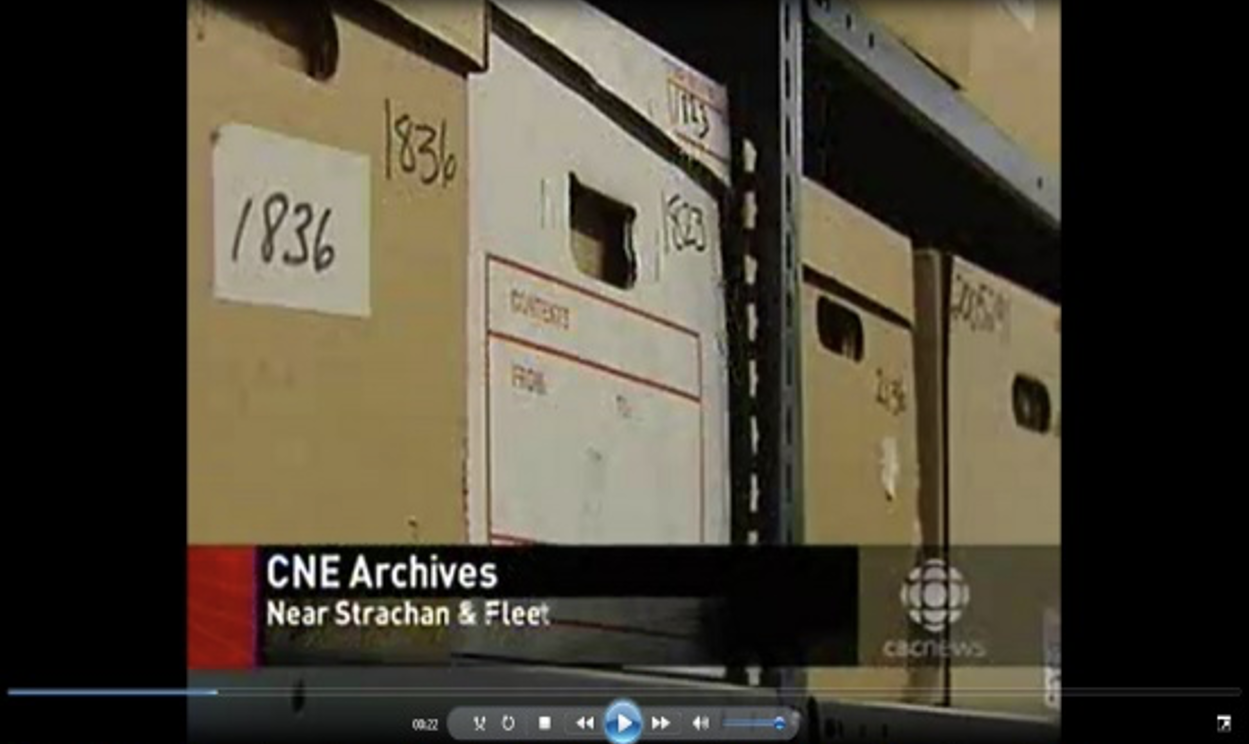
There were countless people at EMC who made that journey exciting: Jennifer Dreyer, Susan Hass, Ross Allen, Sandra Vazquez, Mumo Musembi, Dave Farmer, Gil Press, Ken Steinhardt, Michael Gallant, Michael Kerr, Mike Sharun, Barb Dahan, Joyce Rose, and many others. Through EMC press events, I also met Mike Martin and Chris Rogers when they were journalists. They both became my colleagues and friends.
KPMG Enterprise’s ‘That’ll Never Work’
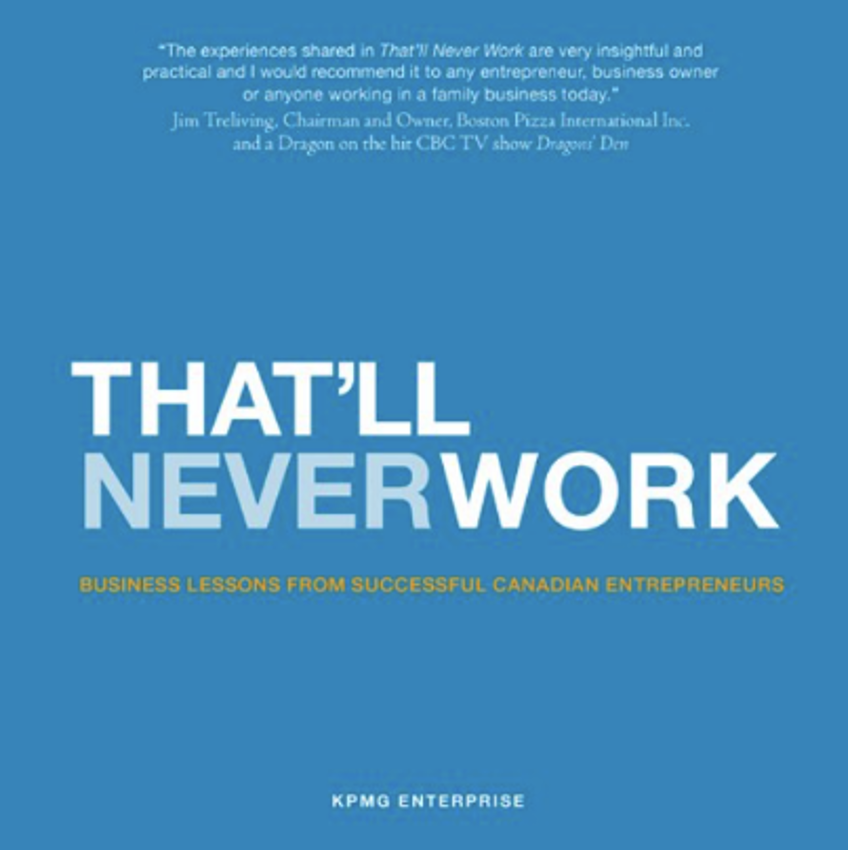
We wrote a book. That’ll Never Work – Business Lessons from Successful Canadian Entrepreneurs. It was a #1 Non-Fiction Book on CBC and made the National Post bestsellers list for business books. Thanks to Tracy Holotuk for entrusting us to write the Canadian edition. We accepted this unconventional project and managed to get the book completed in 10 months. During that time, whenever I walked by Adam Pletsch’s office (Adam is one of the best writers and editors), I could hear a booming voice coming out of his speakerphone. I knew then he was speaking with one of the 19 entrepreneurs. There was one commonality among them: their passion was palpable, and their excitement echoed down the hall through closed doors. The icing on the cake? They needed more voices from women. I turned to Tracy and said, “What about Gayle?” We got to feature our very own Gayle Robin and her journey as a small business owner. She has, along with Miles Pollock, operated StrategicAmpersand successfully for 33 years. They were ahead of their time, integrating marketing, digital, content and communications from the beginning. I have seen them navigate through the tech bubble, the dot.com bust, the financial crisis, the pandemic and the recent slowdown of the tech sector. I owe a huge chunk of my career to them. I am glad their story of perseverance was shared – forever in print – and celebrated.
Procore’s ‘How We Build Now Canada’
I absolutely love working with Procore because of the diverse and imaginative ideas we have jointly created to tell relevant stories. We have had the opportunity to work with some of the best and nicest people in the field – Doug Madey, Harry Battu, Jas Saraw, Raelle Alfaro, Carey Larson, Arabi Siva, Brianne Price, Kevin Molloy, Sasha Reed, Kimberly Corlett, Roohi Saeed, Elizabeth Locke, Lilly Albertz, Andee Brooker, Nolan Frazier, Harsh Gupta, Zachary Reiss-Davis, Natasha Callender-Wilson, Professor Arjun Pandey, Dr. Reva Bond, Adam Freill, Anthony Capkun, Arnie Gess, Blake Marchand, Elle Bremmer, among others. We were proud to be a part of the How We Build Now research project during the pandemic in 2020 and again in 2023 to help identify and amplify some of the most pressing issues the Canadian construction industry is facing today, including skilled labour shortage, housing shortage and sustainability needs.
Nikon and CONTACT Festival
For many years we collaborated with Nikon Canada to create and manage an annual photo contest during the month-long CONTACT Photography Festival in May. The opportunity to see and share some of the most beautiful images from thousands of Canadians was exciting. I got to run my favourite program with Gregory Flasch and Amanda Mohammed from Nikon, along with Darcy Killeen and Tara Smith from CONTACT, whose work and public installations have changed the landscape of Toronto and beyond with their festival. I hope they find more financial support during these challenging times.
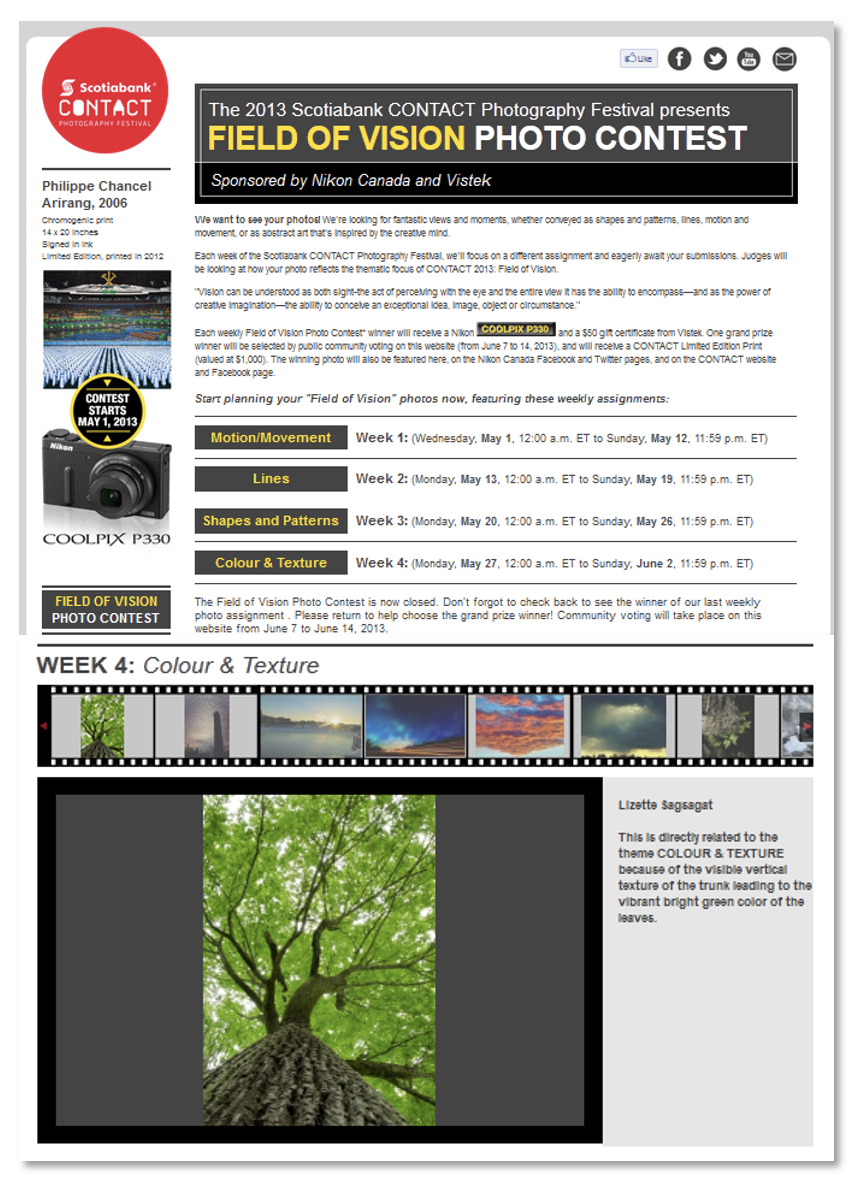
I cherish our almost two-decade partnership with Nikon Canada. Thanks to Mark Cruz, Chris Ogonek, Michelle Valberg and Kristian Bogner for sharing their knowledge and passion. Learning from Nikon experts helped fuel my interest in photography 15 years ago, setting me off on a journey to capture images of dance movements and wildlife.
BlackBerry Fact Check

Working with homegrown companies has always meant a great deal to me and StratAmp. We were honoured that our idea of a Fact Check portal was accepted (thanks to Heidi Davidson) and implemented in 2014-2019 (and relaunched in 2023) to help fight back against inaccurate and groundless claims from BlackBerry’s competitors. I got to work with many great people from that team, some of whom we’ve had the opportunity to collaborate with on projects post-BlackBerry.
OpenText Enterprise World Toronto
Another Canadian company we are proud to have represented is OpenText. We had the best time working with Kasey Holman, Tim Brook, Eileen Foley and Ryan Hill on Enterprise World when the conference returned home to Toronto for three years. I want to thank Lynn Greiner who had some of the most fascinating discussions with the CEO during the first year, as well as Robert Dutt, Mark Cox and Shane Schick (more on Shane later) who would spend three days with us every year at Enterprise World Toronto. It was always fun to hang out with our favourite journalists in the press room. For three years, we worked hard to identify relevant angles so the Globe and Mail, the Financial Post and BNN Bloomberg would return to cover the conference.
P.S. Novell became Micro Focus which became OpenText … the ever-changing world of technology.
CDW Canada’s ‘Teaching with Technology’
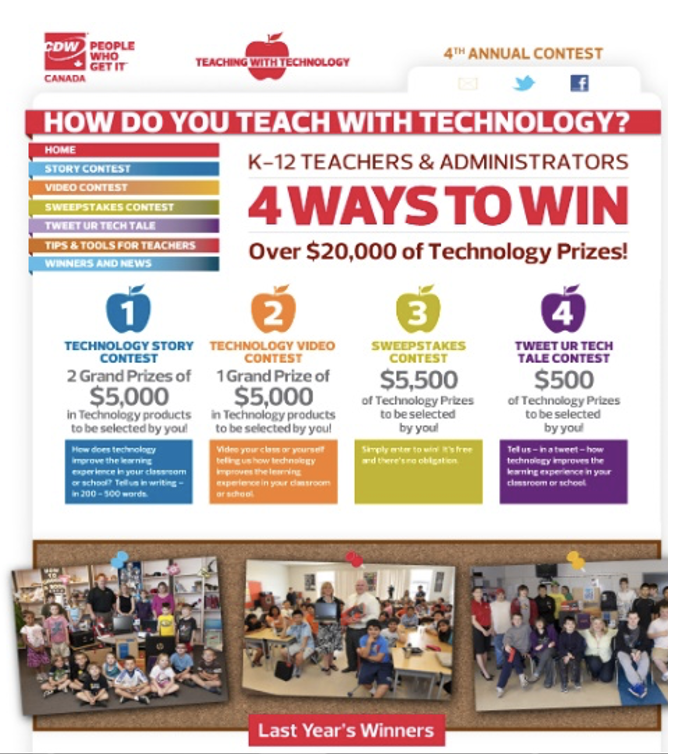
One of the most impactful projects in our 13-year engagement with CDW Canada was the Teaching with Technology program. The original sweepstakes campaign originated from its US headquarters. We took it a few steps further by adding an essay component where educators could share how they teach with technology. Social media was in its infancy then, but we went beyond paper and online channels by introducing submissions through Twitter and YouTube. We also started a Twitter account for teachers to share resources others could use in their classrooms – a community which grew to more than 6,000 educators across Canada in a short time. Thanks to Julie Clivio for her trust and collaboration. For four years, we received thousands of submissions. We generated articles year-round, featured many deserving educators, and helped gather hundreds of leads for the sales team. At one of many prize presentations at an elementary school that had won an extensive technology package, J.D. Hupp of CDW Canada said, “This is my favourite part of the job.” We couldn’t have agreed more.
McAfee Executive Summits
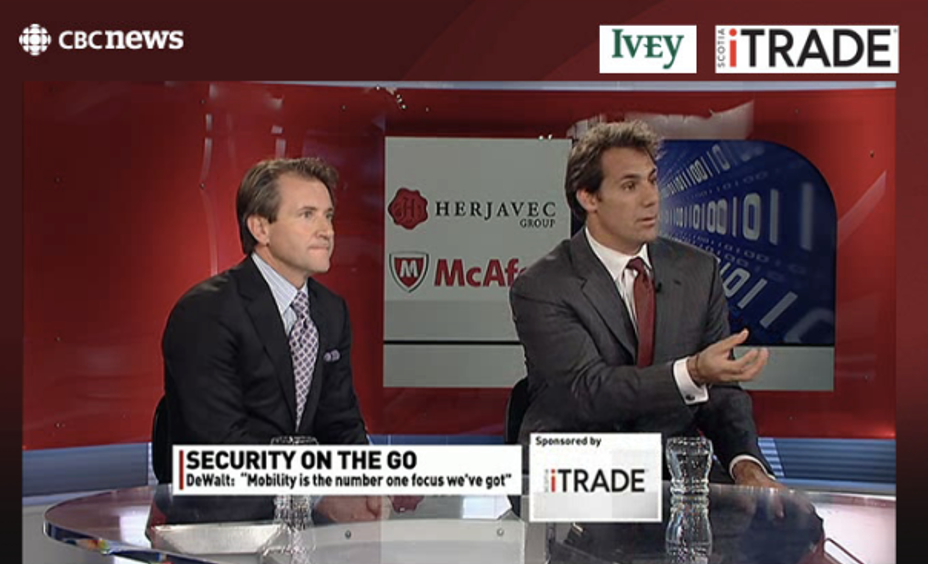
We had an unforgettable decade-long partnership with McAfee thanks to Ross Allen, Doug Cooke, Regan Ogner, Lindsay Liptok, Mathew Donoghue, Tracy Ross, and many others. Managing McAfee’s Executive Summits topped our list as the most memorable (and nerve-racking) projects. Within six weeks, we pulled off – from scratch – two customer and media events in Toronto and Montreal. (A shout-out to my StratAmp marketing counterpart Lisa Caruso and art director Illya Noble.) Then CEO Dave DeWalt met with media and did back-to-back interviews, on top of hosting and meeting with hundreds of customers, partners and employees. The Canadian summits were so successful that we were invited to manage the events in New York City and Boston.
SurveyMonkey Ottawa Expansion
Our project work with Irina Efremova of SurveyMonkey is noteworthy to me because it demonstrated that true collaboration, a customized approach, and focused objectives and benchmarks can pay off. We offered each of these outlets a unique topic: BNN Bloomberg (growth story with CEO Zander Lurie); The Globe and Mail (second HQ discussion, and a contributed article for the Globe’s Leadership Lab); Financial Post (identified key macro topics of interest to the Post and offered exclusive use of the SurveyMonkey data to the tech reporter, resulting in two articles in its ‘Innovation Nation’ series, and a contributed article from the HR lead); Financial Post Magazine (a survey on the top 10 ranking of admired CEOs and corporations, in conjunction with FPM’s FP500 edition); IT World Canada (new enterprise solution); B2B News Network (interviews with the CEO on post-IPO competition; with the CMO on her journey; and with board member Dean Erika Hayes James on lessons around big data, analytics and AI); Ottawa Business Journal (job creation in Ottawa and office culture); and Direct Marketing Magazine (a thought-provoking article based on the result of its Brand Trust survey). We focused on quality over quantity and obtained the desired results.
We got to work with Irina again on Roblox and it was another rewarding experience.
Collaboration with Shane Schick
This isn’t a project, but working with Shane over the last 20 years has been one of the highlights of my career. I’ve learned so much from attending Shane’s interviews and reading his articles. His questions are always meticulously researched and posed so he gets the most out of each interviewee. He explores diverse topics with ease and manages to weave together seemingly disparate conversations in a seamless way, which creates very compelling writing.
Sometimes, it can take a couple of years to find the right angle for a client before approaching Shane. I remember every interview with him and invite you to join me down memory lane:
From 360 Magazine: Beanfield, Procore, Waze, Linktree and Gartner
From B2B News Network: Commvault (the CMO spoke with Shane from the South Pole via a satellite phone), CDW, SurveyMonkey (CMO and Dean Erika Hayes James) and OpenText (e.g. Malcolm Gladwell, Tim Berners-Lee).
From ThirtyK: OpenText (This was a last-minute interview request from Shane on day 3 at OpenText Enterprise World, after he attended one of many breakout sessions. The insights garnered during that conversation based on Shane’s perceptive questions spawned an idea for an article, resulting in a forward-looking piece a few months later.)
From ITBusiness: Novell (Yes, it was 2004. This was when I met Shane in person for the first time after many phone interviews.)
Our Work with Black Health Associations
In the last year, it has been a humbling experience to collaborate with Chenai Kadungure, Dr. Andrew Thomas and Dr. Mojola Omole of the Black Physicians’ Association of Ontario (BPAO); Abena Addo and Dr. Nik Whyte of the Black Healthcare Professionals Network (BHPN); and, Alice Wiafe of Black Mental Health Canada. They have worked tirelessly in advocating for their causes and it has been our honour to be able to share their stories. Olivia Bowden, Daniel Reale-Chin, Laura Stradiotto, Shree Paradkar, Jamie Bussin and Dr. Vibe deserve special acknowledgement as these journalists and podcasters have continually put a spotlight on important issues.
And More …
There were many more meaningful projects we have done over the last 25 years: Beanfield’s fight for consumer choice; what3words’ life-saving navigation app; Cradlepoint’s annual survey exploring the impact of connectivity on Canadian businesses; the ‘Share Your Sony Experience’ contest celebrating the Sony store’s 20th anniversary; Schneider Electric’s community town-hall engagements; Waze’s discussion around mobility for a post-pandemic future; Aptum’s work to guide companies along the cloud journey; and Trilliant’s solutions that help utilities with energy transition. As Gayle often says, “These projects are like Anita’s children.” I try not to play favourites, but there are too many to include here.
25 Years Later
Over the years, many people have asked me in a variety of ways why I have stayed with the same company for this long. Beyond the support, autonomy and trust that Miles and Gayle provide, I get to experience a new beginning whenever we start an engagement, or a project for longstanding clients. I have the chance to work on a wide range of subject matter; immerse myself in different industries; learn from and engage with clients ranging from marketing and communications professionals to CEOs, small business owners, sales executives, engineers, researchers, educators, physicians and healthcare providers; explore and experiment with different ways to tell stories to reach varying groups of people; and study, pitch and work with knowledgeable journalists who cover topics from technology and business to healthcare, travel, construction, and many more. There is a new challenge — and opportunity — every day.
Ultimately, though, what makes all the work meaningful beyond the purpose and content remains the people. Clients who are devoted to the mission, the operations team who has supported us behind the scenes (Janice Young, Carol Jensen, Elena Kostenko, Irene Kwong and Andreas Bach), business partners who are an extension of our team (Gary Ralph, and many of our global agency partners), colleagues who are committed to delivering the best outcome (too many talents, past and present, to list here), and journalists who work with us and challenge us to tell relevant stories objectively.
I wouldn’t be here 25 years later were it not for all the people along the journey. This is my tribute to them all.
Navigating the Post-Cookie Era in Online Advertising

The digital advertising landscape is undergoing a pivotal transformation with Google’s announcement of the gradual phase-out of third-party cookies, which followed limitations already placed on cookies by Firefox and Safari. This change signifies a broader industry movement towards prioritizing user privacy, which is reshaping and limiting the strategies and tools available for online advertisers.
While this shift presents new challenges, it also opens opportunities for more innovative and privacy-conscious online advertising alternatives.
The Challenges of a Cookie-less World
The decline of tracking cookies is a direct response to growing concerns over user privacy and data protection. The absence of these tracking mechanisms poses significant challenges for online advertisers:
- Less Online User Data – The move away from cookies, while it increases user privacy, reduces advertisers’ ability to access detailed personal browsing data for tracking audience behavior.
- Targeting Difficulties – Without the convenience of cookies, advertisers face hurdles in gathering sufficient online behavioral data to personalize and target their ads for relevant audiences.
- Strategic Pivot – There is a pressing need for advertisers to develop new, privacy-compliant targeting strategies that do not rely on the traditional third-party cookie-based approach.
The Opportunity: Social Targeted Programmatic Advertising
In response to the changing landscape, Social Targeted Programmatic Advertising emerges as a better alternative. But first … this is NOT ads placed on social media sites. This approach leverages sophisticated AI algorithms to analyze actions and interactions – comments, likes, shares, follows, audience profiles, etc. – acquired from LinkedIn, X/Twitter, YouTube and Reddit:
Social Posts – Text analysis of users’ social conversations
Audio – What people say and listen to on podcasts, videos, radio, etc.
Video – Content of videos that viewers like, share and watch
Images – Content of images people post, share and like
Competitors – Followers of competitors’ social media accounts, and/or mentions of competitors
LinkedIn Profiles – Company, industry and skills of prospective audiences

Plus, ads for your audiences can be geo-targeted to any location – countries, cities, conference centres, office buildings, etc., around the world.
Again, this is not about ads delivered on those social media platforms. Rather, it is a sophisticated means of leveraging the plethora of information about the interests, behaviors and preferences of social media users. When a prospect is identified, a unique methodology assigns an ID that incorporates the user’s device ID, enabling closely-targeted ads to be delivered to the user wherever their online habits take them — on websites they visit or web apps they use.
Since users freely share their information and activity on social media sites, there are no concerns for privacy or security of data.
Advantages Over Cookie-Based Advertising
Shifting to Social Targeted Programmatic Advertising delivers both strategic and tactical advantages over traditional cookie-based online advertising:
- Rich Data = Effective Targeting – Social platforms offer a treasure trove of zero-party user data, ranging from content interactions and insights to profile information. The result … a more rounded and effective targeting strategy based on real users’ online interactions.
- Custom Audience Creation – Advertisers can create custom audiences using the rich data available from social platforms, driven by your unique advertising needs and interests.
- Pinpoint Audience Targeting – Unlike cookies, this approach enables highly-relevant contextual targeting, and can track user identities seamlessly across different devices with laser precision.
- Cost-effectiveness – Since Social Targeted ads are delivered only to highly relevant audiences, budgets can be leveraged to reach more prospects in more markets.
- Increased ROI and Sales – Social Targeting fosters deeper engagement with audiences for better targeting and higher likelihood of delivering on sales goals.
- User Consent – Social Targeting respects user privacy by relying on consent-based data collection, in alignment with today’s privacy standards.
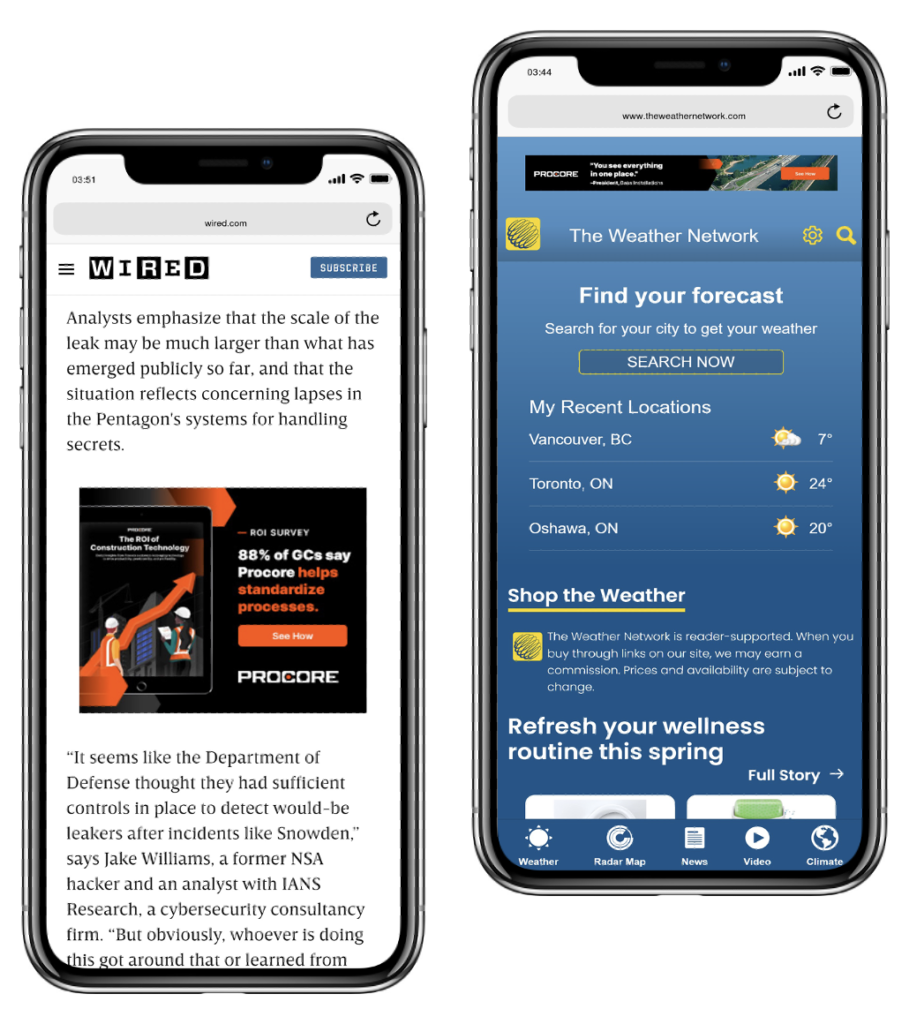
The Demise of Cookies Need Not Be Daunting
As we step into a new era of online advertising, the end of cookie-based methods presents an opportunity for innovation and growth. Social Targeted Programmatic Advertising stands out as a compelling, highly effective solution for advertisers seeking to navigate this transition successfully. It offers a uniquely effective pathway to achieving advertising goals while respecting user privacy and adapting to the changing digital landscape.
Learn how other companies are enjoying the benefits of Social Targeted Programmatic Advertising, without the need for cookies:
View Some Informative Case Studies
For a more in-depth look at how Social Targeted Programmatic Advertising can support your unique needs and strategies, please contact gayle@stratamp.com.
From Lead to Close: Why Every Company Needs to Use Sales Playbooks

Though sales and marketing have distinct functions, they are closely inter-connected in business (a complementary pairing … wine and cheese anyone?). Ultimately, marketing exists to support sales. So marketers are constantly thinking of strategic ways to support key business objectives through external activities designed to drive demand and generate leads for sales engagement.
But let’s stop there for a moment. Once marketing has done its job and leads are in the hands of sales, what happens? Do the sales folks have concise yet in-depth knowledge to give them the best chance to close on the prospects marketing delivers?
For sales organizations there can be any number of issues, challenges and questions impacting their ability to close a sale. They can include, for example, inability to properly qualify and probe customers and prospects, uncertainty when faced with handling customer objections, or even lack of product or solution depth of knowledge. Regardless of the number of leads marketing may deliver, it is important to give sales the best chance to close on them, and avoid giving competitors an advantage.
In this context, sales enablement should be considered as important as demand generation. A great way to support the process is a Sales Playbook – an effective resource to prime the sales force for optimal performance and ability to capitalize on all opportunities. Done correctly, it is a powerful all-in-one reference guide (typically a clickable PDF or web page with content tabs) that is an essential tool for the organization’s sales force.
Let’s take a look at some common elements of a Sales Playbook:
At-a-Glance – Sets the playing field with an overview of background trends and issues; the opportunities that exist; key challenges or business issues faced by customers and prospects; and how sales can pitch the benefits of their product/solution to solve customer challenges and close more sales.
Product Overview – Defines key purpose/value, features and functionality, services associated with the product (e.g. post-sales support, training and education), new features planned for the coming months, etc.
Value Proposition – Equips sales with compelling arguments to convince prospects to buy from them. Includes key differentiators, competitive advantage, and the overall value proposition.
Sales Opportunity – Provides clear reasons/rationale customers will be interested in buying including concise product/solution positioning, detailed customer challenges and pain points, clear product/solution benefit statements addressing the challenges, and specific sales opportunities to help identify target accounts.
Prospecting Guide – Steps to create the best opportunities for moving prospects through the process leading to a sale. Includes tips to qualify and probe so questions can be focused on determining the prospect’s key challenge or needs.
Competitive Landscape – Summarizes key competitor market positioning, outlining each of their offerings in detail to help the sales force better understand likely questions they will face, and suggestions for how to frame their sales presentation.
Handling Objections – Overviews common objections such as features, price, integrations, current contracts or budget considerations, and how to respond to them, including common prospect questions and recommended answers.
Promotions/Special Offers – Outlines promotional offers that are available to make it easier for customers to help sales move the process forward and convince prospects to invest in the product/solution.
Resources – Helpful reference materials to deepen sales reps’ knowledge such as relevant third-party content, customer case studies, usage guides, training tools, etc.
The true value of a Sales Playbook is that all key selling information is presented in a single-source, easy-to-use guide that elevates performance of the sales force, leading to more sales.
StrategicAmpersand has produced many such Sales Playbooks for our clients, and seen the great results. In that way, we serve as a key external member of our clients’ marketing/sales organizations. If you’d like to talk or see some samples, please contact lisa@stratamp.com.
Design Matters?
By Illya Noble, Senior Art Director
As a veteran graphic designer and art director with over 30 years of experience, sometimes you start to ask yourself if what you do for a career really makes a difference in anybody’s life? Of course, it’s a way to make a living and support your family and do the things that interest you. But really, does it matter?
And this happened.
A friend and I were attending a music concert and while grabbing some refreshments and heading to our seats before the show started, I heard someone calling my name. I turned to see who it was and I recognized the face from my distant past. It was the widowed wife of an old high school buddy who tragically died from cancer at the age of 38. He left behind two daughters as well who are now grown up and have their own families.
This old friend gave me one of my first design projects after we both graduated college, 36 years ago. He needed a logo for his new landscaping business. The company name was Mike Davis Landscaping. The following is a rough sketch from my recollection of the logo as I have no digital record of it. I gave my friend the master artboard, because that’s the way we did things back then. The final artwork was created using a rapido-graph ink pen on a cold-press artboard. Times sure have changed!

My old pal Mike was very appreciative of the design and it was his company identity for his business until he passed away. It was on all his trucks, ads, corporate identity, shirts, etc.
Catching up with his widow at the show, one of the last things she said to me was about the logo, that brought a tear to my eye. Mike’s daughters knew how much pride their Dad had in his company, his people and the work they did and the logo was always a positive symbol for him. In memoriam of their dad, they both had tattoos of the logo on their arms.
Maybe design matters just a little bit.
Improve Results from Your Events with Targeted Digital Advertising

Industry events are an important tool for marketers due to their ability to deliver targeted audiences and provide valuable opportunities for engagement. Whether you’re staging an event, participating in a third-party event as a speaker and/or exhibitor, or even just attending an event, it’s usually a significant investment and companies must make every effort to maximize its ROI.
Post-pandemic, live and hybrid events are once again drawing significant audiences. From a communications perspective, it is important to consider what you will do before, during and after the event to attract and engage attendees.
This is where a carefully planned and executed digital strategy can have a major impact on your event KPIs. For example, programmatic and social targeted programmatic advertising are highly effective in generating awareness, engagement and actionable leads. This automated form of online advertising enables us to identify and reach audiences in real-time, wherever they are, to deliver desired messages and calls-to-action (CTAs), all while measuring response and optimizing audience reach.
Now let’s think about how we can use this compelling form of advertising when it comes to live- and hybrid-event communications:
- Leading up to the event, give people compelling information about what they’ll learn and the insights they’ll gain.
- During the event, drive visitors to your booth, generate attendance at keynotes and information sessions, and even cross-promote valuable content.
- After the event, share event presentations and continue to amplify content to nurture audiences you reached at the event.
Sounds great, but how?
Programmatic offers a broad yet targeted approach. Audiences are identified through browsing behaviours (keywords), location, and through first- and third-party data. Unique to programmatic is the ability to re-target audiences who have clicked on an ad, so you can continue to reach event attendees after it concludes, for maximum frequency and engagement.
Social targeted programmatic relies on audiences to self-identify, based on their expression of intents and interests on various social media. The platform uses artificial intelligence (AI) to establish define and reach target audiences based on analysis of their social media activity. This can include comments and content people post; pics and videos they interact with; your competitors they follow or comment upon; and content of their LinkedIn profiles, including company, industry and skills.
Key to getting the most out of both these media goes back to having a carefully planned and executed campaign strategy. Here are some key considerations:
Campaign Objectives – Ensure your campaign objectives are clear and measurable; establish KPIs at the outset to drive an effective overall approach.
Targeting Alternatives – Leverage the most appropriate media — programmatic, social targeted programmatic, or both. While there is some overlap in how they define and reach audiences, good media planning will maximize results.
Creative Strategy – As mentioned, event targeting delivers an important yet niche audience, and provides a great opportunity to align content, messages and CTAs to the event agenda. For example, banner ads can promote event attendance before the show; then during the show they can be used to drive attendees to a booth or session; and after the event, promote valuable content such as a third-party report, case study or blog.
The ads you deliver can be split-tested and optimized according to results, so the better performing ad is shown more often, to maximize results.
Impression Delivery – Budget and Timing – This is variable and unique to each campaign depending on objectives and strategy. We often recommend a controlled test campaign for the first event, followed by an analysis and broader roll-out that leverages key learnings.
Campaign KPIs – Measurements can include impressions, clicks, click-through-rate (CTR), cost-per-click (CPC), content downloads (gated vs. ungated), page hits, page depth, overall spikes in website traffic during the ad campaign, conversions, and more. It is important to establish the campaign KPIs at the outset to ensure the campaign parameters are set up correctly for reporting purposes.
CASE STUDY: SUSE connects with audiences at SAP Sapphire
SUSE, a German-based multinational open-source software company used social targeted programmatic to promote their participation at the SAP Sapphire event, and drive traffic to the SUSE booth. The targeting strategy leveraged tactics both before and during the event.
Two weeks prior, audiences within specific geographic markets were targeted based on their LinkedIn work profiles, social media conversations and engagement, text analysis of keywords, and those following competitive accounts and/or talking about competitors. Once the audience was identified, ads were served to identified targets within 40 minutes of qualification. The ads promoted SUSE’s participation at the event, and also drove to a relevant third-party report.
Pre Show Banner Ad:

Show Duration Banner Ad:

At the show, only attendees at the event venue and nearby hotels were targeted with messaging driving them to the SUSE booth and to key sessions.
This result … above-average click-through rates, an increase in content downloads (for the particular report) and higher levels of activity at the event. Pre-show, the campaign delivered 361, 859 impressions, 4,604 clicks and a CTR of 1.27%. At the show, 139, 209 impressions were delivered, generating 1,778 clicks and a 1.28% CTR.
If you’d like a no-obligation consultation, or to receive a free customized proposal for a campaign to support an upcoming event, please contact me – Lisa@stratamp.com.
Yes, Customer Case Studies are Still Valuable in PR
By Cindy Watson, Director of Public Relations

Journalists’ time is always precious, but in a world where media outlets are consolidating and often operating with limited staff, public relations professionals need to be even more thoughtful about the material we’re creating and pitching, ensuring we’re offering relevant and useful content.
With decades of pitching experience on our team (and personally, as a former journalist who was once on the receiving end of pitches), we’ve found one of the most valuable things an organization can do to pique media interest is to leverage compelling, educational and validating customer case studies.
A customer case study is typically a short overview of a business problem; the solution they chose to address it (including how and why that particular solution was selected); and the resulting outcomes. Whether in a structured format/template, or simply outlined as a media pitch, here’s why customers’ experiences are so valuable, how we successfully leverage customer case studies and why they should be a priority when it comes to your PR strategy.
The customer advantage
It’s important to understand why editors are interested in this sort of content. Here’s what makes customers’ stories so valuable:
- Readers can identify with customers, because many of them are facing the same business issues.
- Customer examples allow organizations to tell a much fuller story about their offerings and the outcomes their customers realize, than just listing a couple of bullets with benefits, like you might have in a brochure or press release.
- In my previous life as a tech journalist, it was actually a requirement that every story our editorial team filed included at least one customer. While a company can tout the benefits of its products and solutions all day, their information and opinions are not considered impartial. A journalist’s job is to report the facts, so offering a user who can share their experiences means the writer is getting a third-party source and unbiased insight into the topic illustrating how a solution works.
Putting the pieces together
While telling a customer’s story might sound easy enough to do, our team has learned over the years there are a few considerations to keep in mind.
Firstly, simply identifying a customer is not enough. The customer needs to be qualified to ensure they’re an appropriate choice before any other steps are taken. We like to touch base with the customer’s account manager to get the background first, and then have a conversation with the customer before any writing or pitching begins to explain the process and requirements and to confirm a few things:
Is the company willing to have a case study written about them and do they have buy-in and approvals from their internal communications (and in some cases legal) teams for a case study and/or subsequent media activities? Sometimes case studies and pitching get stopped dead in their tracks because of a lack of internal approvals, so this needs to be confirmed from the outset. Having the go-ahead from an IT person or the contact who paid for the solution is not enough; the marketing, communications and legal teams often need to be involved in the conversation.
Sometimes customers might be willing to take part in a case study but are unable to participate in media interviews for various reasons. In those situations, we identify ways to pitch the case study and secure an article in the press without a customer interview. For example, see this full feature story on a successful implementation in a Canadian city where the case study was used by the editor. It can be done, but careful considerations with customer’s buy-in and the right media outlet are crucial.
What’s the experience they have to tell? Will it be something that will be interesting to the media and the outlet’s readers? We want to ensure we’re highlighting a solution that is a priority for our client, and that the customer had a smooth and successful implementation. There should be clear, quantifiable results, so ideally we like to capture the story six months after the implementation (or more). When speaking with the customer to gather information, we are watching for how they might perform in a media interview setting as well.
Even if a story isn’t ideal for media, it might still be valuable for our client to develop a case study for their website to leverage for marketing purposes and promote through social media.
Adapting for the best results
It’s important to note not all customers are the same and they have varying levels of comfort. Like the example I gave earlier, maybe they don’t want to participate in interviews but are happy to have the case study pitched. Perhaps they don’t have the time to do an interview with us but there are other materials available for us to use.
Recently we worked on amplifying the news about a smart water metering solution implementation at a townhome complex in Ontario. The customer wasn’t available but we developed a press release and pitch outlining the details. This landed us a media interview, and our client was able to provide the journalist with an extensive overview of the implementation and industry practice. As soon as the press release and media coverage went live, our client started to get inquiries from prospects.
There are other customers who are very enthusiastic about sharing their positive experiences. In one situation, a customer took part in a webinar with our client, which we attended. Post-event, they were willing to share their experience with the media. We sprang into action and put on our journalist’s hat. We pitched and secured a contributed article with an outlet and wrote the piece based on learnings from the webinar. This article is an example of what is possible. The customer did not have to do anything beyond approving the article before it was published.
We’ll often come up with options for leveraging a successful customer implementation, keeping the customer’s comfort level and availability in mind.
There are many ways to convey a customer’s experience and successes – from a formal case study, to a media pitch highlighting their results. Not every customer is an ideal subject, but finding one with a good story will give the PR team highly relevant and interesting angles to pitch to editors, resulting in a credible way to connect with your potential customers.
Related stories:
Customer Spotlight: Procore & Bass Installation
what3words: Raising Awareness of a Life-Saving Navigation App
Trilliant Partners With the City of Cowansville
City of Calgary + Waze data-sharing partnership
Generate Leads with Social Targeted Programmatic

Target prospects based on their interests, intents and profiles expressed on social media
Programmatic advertising makes it possible for B-to-B marketers to reach audiences based on keywords searched, physical location, competitor interest and more. Delivering ads to these acquired audiences is very effective for generating awareness, interest and engagement.
But programmatic has evolved to become even more effective at reaching highly-defined audiences. Now there’s an approach to targeting audiences based on the ways people are acting and interacting on their social media – the comments and content they post, the images and videos they view and share, the places they visit, and more.
Social targeting raises programmatic to a new level
This kind of social targeted programmatic advertising is a direct indication of the intents and interests people express on social media. For B-to-B marketers, audiences are acquired from Twitter, Reddit and YouTube. And now … audiences can also be acquired based on their LinkedIn posts and user profiles!
But make no mistake … this is NOT a form of advertising on social media sites. Audiences are ‘acquired’ on those social media, then advertising is delivered through traditional programmatic channels – websites people visit or apps they use, most often on their mobile devices.
Here’s how social targeting works …
Audiences are identified using an artificially intelligent mobile ad platform that analyzes social media activity to establish targeted audiences, then serve them contextually relevant ads in virtual real-time. The audiences come from the following sources (with full respect for privacy regulations in all cases):
LinkedIn Profiles – people are targeted based on their company, industry and skills.
Social Posts – people are targeted based on their social conversations. Posts are analyzed based on identified keywords, topics, brands, and/or phrases to identify the intents, interests and attitudes of the social media users.
Images – people are targeted based on the images they view, like and share.
Videos – people are targeted based on analysis of the videos they view, like and share.
Places – people are targeted based on where they go in the physical world, and their intents for doing so (e.g. a trade show or office building).
Competitor Followers –people are targeted if they follow competitor accounts, or talk about competitors
Any or all of these audiences can be served engaging, highly-relevant advertising via the web apps they use and the websites they visit on their devices.
Many companies have learned the benefits of social targeting
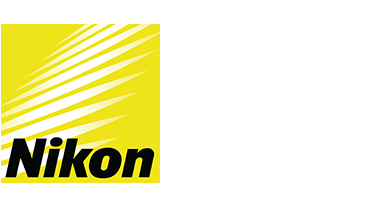
- Nikon’s Winter Sales Event is an annual program to drive awareness and engagement for prospects interested in camera equipment for holiday season gift giving.
- They leveraged a social targeted programmatic advertising campaign for Canada, acquiring audiences based on keywords in social posts, as well as people who talk about competitors or follow the accounts of competitors.
- Driving prospects to a Nikon Winter Sale e-commerce site, they achieved a 1.53% click-through rate (CTR) which was as much as 6.5x the response rate of their traditional programmatic ads.

- This worldwide leader in Workforce Management solutions recognized traditional email channels were losing momentum.
- They leveraged a social targeted programmatic advertising campaign for Canada and the results were dramatic – an exceptional 1.63% click-through rate yielding tens of thousands of website visits.
- Over 1 year, website traffic increased 11%, inbound call traffic increased 200%, and the company’s marketing influence pipeline increased 60%.
Let’s talk about how we can customize a Social Targeted Programmatic advertising campaign to achieve your objectives.
Where Have 30 Years Gone?
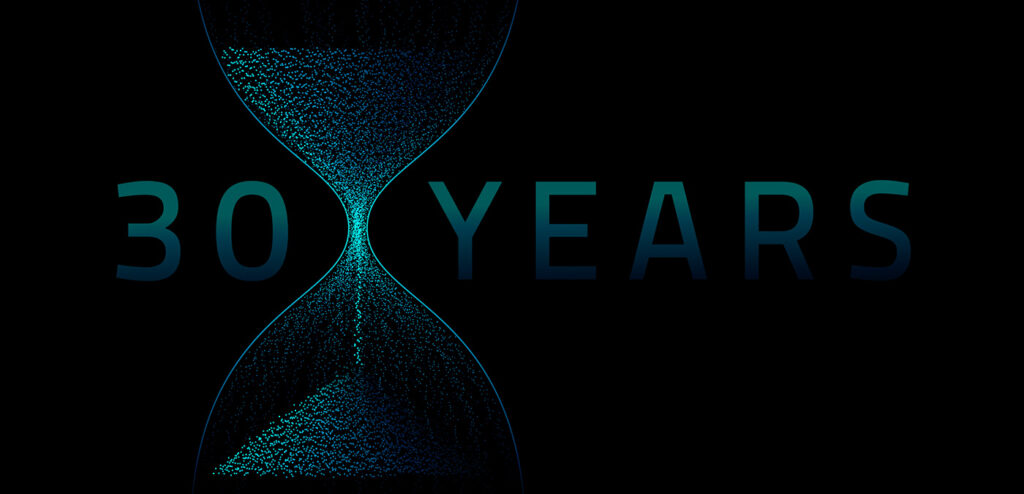
In 2021 StrategicAmpersand hit an astonishing (to me and my partner Miles Pollock) milestone. We celebrated 30 years in business. And not just in business, but in business together, as business partners. And yes, we still really like and respect each other! And no, we’ve never been a couple.
There were many discussions about how, or even if we would mark this momentous event, whether to celebrate or not, create noise and fanfare, pat ourselves on the back, take out thank you ads, produce a video, throw a virtual party (ugh, no), send out swag, do a blog series, throw a medallion on our website and collateral, or just quietly keep on keeping on. We sort of slipped into 2022 before ever making a decision, too busy with client work and honouring our tradition of being the shoemaker’s children, believing our reputation, amazing team and loyal clients that have kept the door open all these years and for whom we are eternally grateful and perennially appreciative, were enough.
PR In Canada recently asked us some questions for the Agencies Anniversary series and it got me thinking about the past 30 years, as well as what the future may hold. And at our age, we do think a lot about the future, while trying to remember what we did yesterday.
We are so grateful for the amazing clients we’ve worked with over the years, without whom, we wouldn’t be here at all. Companies, who often when we started working together were small, scrappy and agile, and we became extensions of their organizations. Clients like Cisco who we worked with for 26 years (!) Nikon Canada Inc. (17), Sony Electronics (17), Novell (14), Dell EMC (12), VMware (12), CDW Canada (12), Oracle (11), McAfee (10) and so very many others like Aptum, BlackBerry, Celestica, Commvault, Cradlepoint, Gartner, Kronos, Lenovo, OpenTable, OpenText, Procore Technologies, Sharp, Schneider Electric, SurveyMonkey, now Momentive.ai, SUSE, Trilliant, Waze, what3words to name only a fraction of our clients past and present.
These are tenures unheard of in the tech industry and we’re understandably very proud! We’ve had the great privilege of working with the best of the best, from the upstarts, to the kingpins, tech giants and leaders who built our industry and changed all our lives. Only space prohibits me from naming the hundreds of amazing individuals who took a shot and relied on us to be their integrated marketing and public relations partners. You know who you are.
Most importantly, Miles and I wish to thank the hundreds of wonderful people, far too many to name, current and past, who have been on our team, whether as an intern just starting out, or a lifer at 27+ years, like our amazing Art Director Illya, who initially said he’d never work anywhere full time, or our VP PR Anita who, after 23 years truly treats our company as if it’s her own, to Elena our CFO who stepped into Janice’s post-retirement shoes after a 25 year tenure and reengineered our processes, to Carol who keeps the wheels on the bus day in and day out and Lisa, our Head of Client Service who just celebrated her 20th anniversary with us, who possesses the patience of a saint, to teammates Cindy and Steve who give it their best every day, with enthusiasm and dedication, as well as the myriad others, many of whom we keep in touch with and have watched flourish in their personal and professional lives! You’ve all helped to make us great and sustain 30 years in this crazy industry.
Ours is a very crowded industry with new agencies and consultants entering the fray, seemingly almost weekly. You inspire us and keep us on our toes, motivate us to expand and innovate and sometimes school us in new ways of looking at what we do day in and day out. We have you to thank too.
And finally I would be remiss if I didn’t laud the very best business partner anyone could ever ask for – Miles Pollock Co-Founder, Creative Director, Best Marketing Writer in the Industry, Voice-of-Reason, Calm-in-the-Storm, Always-There Great Guy. In 30 years we’ve only had two disagreements. You’re definitely the yin to my yang in every way. Thank you is simply inadequate, but thank you. You know how I feel.
I can’t honestly say, “Here’s to the next 30 years”, because that’s not realistic. But I can say CONGRATULATIONS to us and thank you to everyone who got us here.
How to Get a Job at a Marcom Agency
By Gayle Robin, President, StrategicAmpersand
Every time we place job opening ads on our website, LinkedIn and other related sites we are amazed how many applicants possess very few of the required qualifications. We understand times are tough, especially for recent university grads. It’s hard to catch a break. And sometimes we do interview people who may not have the credentials but their application has caught our eye.

Here are some tips on how to get a job at a marcom, PR or advertising agency:
Applying for the Job
Include a Cover Letter
If we request a covering letter it’s because we want to validate that you follow direction. We want to see how you compose your thoughts and describe yourself and why you feel you should be considered for the job.
Show some resourcefulness. Find out who the hiring manager is. If we ask for a salary range, please provide it and be honest. We know everyone wants to improve their position and increase their income but we want to understand where you fit in the industry, as agency and corporate titles are often misleading and vary from company to company. A good rule of thumb is to provide a range that starts at 10%-15% more than you’re currently earning to what your realistic top end salary would be, given your years of experience.
If you really don’t possess any of the required qualifications then don’t apply for the posted job but enquire about other positions by including a cover letter highlighting your achievements and skills.
Your Resume
We don’t care about the format of your resume but please be sure it’s easy to read and provides all the usual information, including your skills, responsibilities and very importantly, results and achievements. Your resume should not exceed two pages. If you have relevant agency experience, indicate the clients you have worked on. Typos in your resume or missing chunks of time are immediate red flags for us.
The Interview
Do Your Homework
We often receive hundreds of responses, some from highly-qualified candidates. Surprisingly, candidates are often unprepared for an interview. One of the things we look for is people who demonstrate they want to work at our company. We ask questions to see what you know about us, our clients, the work we do, our awards, recent accomplishments and wins, et cetera. If you don’t know about us, why would we believe you want to work here?
It’s okay to ask a few questions before the interview such as:
- Who will I be meeting with? What is their title? Is this the person the position reports to?
- Are you able to share what clients the person in this position would be working on so I may do some preparation before the interview?
- Any other questions you think might help you prepare to beat out your competition and make a lasting impression.
It’s not okay to ask what the salary is, what the benefits are, or how much vacation time you’ll get before we’ve even met.
Finally, we look at your social media presence and persona and we also look to see if you follow us on Twitter or have looked up any of us on LinkedIn.
If we’ve shared who the client is that you may be working on, we will ask you lots of questions to see how much research and analysis you have done about their business as a gauge of your interest in the client, the type of work you’d be doing and to assess your resourcefulness. If we haven’t told you who the client is, then be sure to do some homework to see if we’ve announced any recent wins and at the very least know who our current clients are and be able to speak intelligently about recent work we have done for them. Know what products and services they market and sell and be able to name their key executives.
The Obvious
It may seem obvious, but be on time, or ideally a little early for the interview, even if it’s a Zoom call and take a few deep breaths. Dress appropriately (at least from the waist up). Have or offer samples of your work – only what’s in the public domain. Bring a list of questions you’d like answered if you’re given the opportunity. Have a notepad and a pen.
Don’t Bend the Truth
We know everyone wants to sell themselves and appear competent and skilled. However, we’ve interviewed hundreds of candidates over the years and can tell when you’re exaggerating about your credentials or accomplishments, or stretching the truth. Integrity is in our top three requirements when we assess a candidate. Be honest!
Know Your Weaknesses and Address Them
You’re a bright person. You know where your weaknesses lie and where the holes are in your resume. We’re going to ask you about them (why do you move around so much? Why have you been in the same position for 5 years without a promotion?). Please don’t say it was a lay off if you’re the only one who was let go. Be up front with us.
Be Yourself
Relax. We’re not out to trap you. We want to get to know you. Everyone wants to be liked. You’re probably a very nice person. Show us who you are beyond what’s on the resume. Let your guard down. Engage in conversation. Don’t tell us what you think we want to hear. It won’t serve either of us any good in the end. We have to be a fit for each other. We will ask you some personal, seemingly unrelated questions (though entirely legal!) to try to get to know you a bit. Go with the flow. Be real!
Provide Examples
We will never ask you questions that can be answered with a simple “yes” or “no”. We want to understand how you think, problem solve, listen and assess a situation. Wherever possible, it’s very helpful if you can provide examples as an illustration of a skill or in answer to a particular question.
The Follow Up
Send a Thank You Email
Always send a thank you email on the same day as the interview. Often after an interview, candidates think of something they wish they’d said or had been asked. The thank you email is the perfect vehicle to add a few words. It’s also a good opportunity to inject some thoughts about something you heard or were asked but perhaps didn’t feel you fully answered, and demonstrates your listening skills and enthusiasm.
References
You’ve been through all the interviews and we still like each other and want to proceed together. We’re going to ask you for references. We want to talk to your most recent supervisor. If you’re currently employed and your employer doesn’t know you’re considering a move, then we’d like to speak to the last supervisor or manager you had prior to your previous employer. We might want to talk to a client you’ve done work for. We don’t want to speak to a friend, co-worker, HR or your boss from 10 years ago.
You should also know that we do some digging of our own. And if you’ve been in the industry awhile, we may discreetly check you out with our contacts, colleagues and on social media.
We hope you found this information helpful as you seek out new career opportunities. If you think you’d be a fit with our organization, feel free to send us your resume with a cover letter and let’s see if there is a match.
How the StratAmp Team has Made Remote Working Work
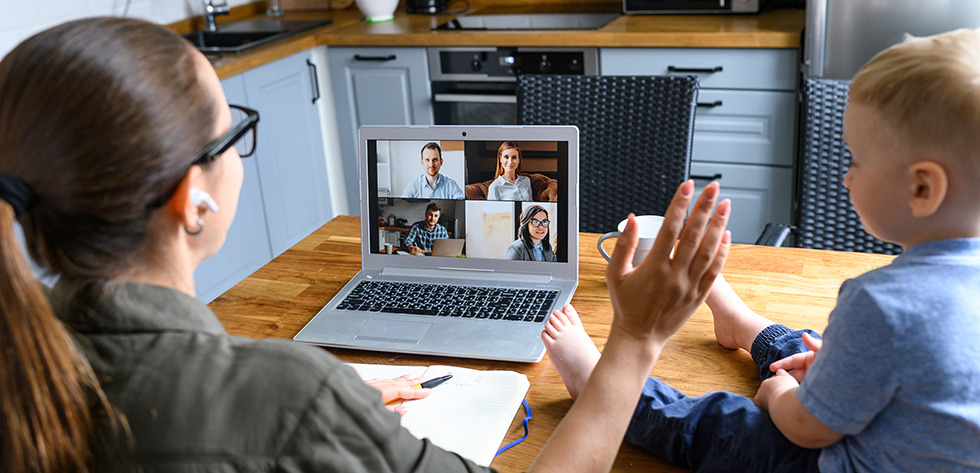
Like many companies, StratAmp has been working from home since March, thrust into a remote work reality we were surprised by, but not unprepared for. Most of the team was already working from home a few days a week, using tools such as Zoom, Slack, Dropbox, Google Docs and Micro Focus Filr to stay connected and productive.
This made the WFH transition easy in some ways, but the impact of the pandemic touches both our work and personal lives. We asked team members to share how they feel about the overall experience. The results serve as a snapshot of how StratAmp has adapted, and suggests how our work might evolve as the new normal becomes clearer.
The biggest challenge of working from home identified by the team was internet connectivity (45%), followed closely by social isolation (36%) and general anxiety about the impact of COVID-19 on our lives (36%).
But what about the social aspects of working in the office? Anecdotally, we’ve found speaking on video calls helps us retain some of the social interaction, even if it can’t replace it. And we’re chatting on video more than ever. In fact, the survey showed we communicate with each other on video calls more than any other method except email and Slack. When communicating with clients, video calls even edge out phone calls. A key transformative statistic is that most of us (73%) are now more comfortable chatting on video than we were before the pandemic.
When asked about returning to the office, given appropriate safety precautions are in place, 54% of us said we’d feel somewhat uncomfortable doing so. The team shared many concerns: getting exposed to Covid-19 while there (82%), getting exposed while travelling to work (63%), and potentially spreading the virus to co-workers (73%).
While only 18% said they’re concerned about organizing childcare when we return to the office, these anonymous results likely represent the concerns of all the members of our team with school-age children.
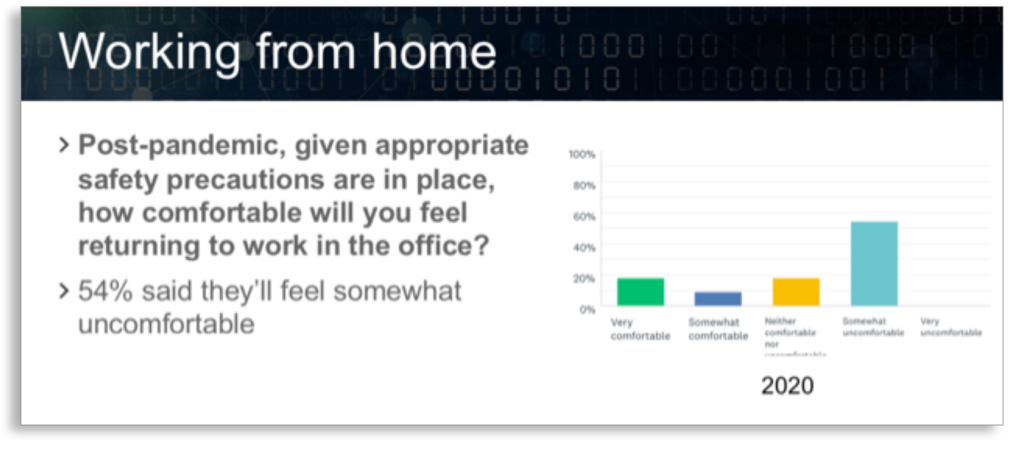
These apprehensions might help us understand how the team answered this next question: “Thinking about your current work from home arrangements, how long is this something you could comfortably maintain?”
No one said it’s unsustainable now, or that they could maintain this for just another week or another month. Interestingly, everyone in the company gave the same response: “As long as necessary.”
Of course, it’s more complex than simply being willing to work remotely indefinitely. There are many reasons the team might feel this way, including the concerns expressed about returning to the office.
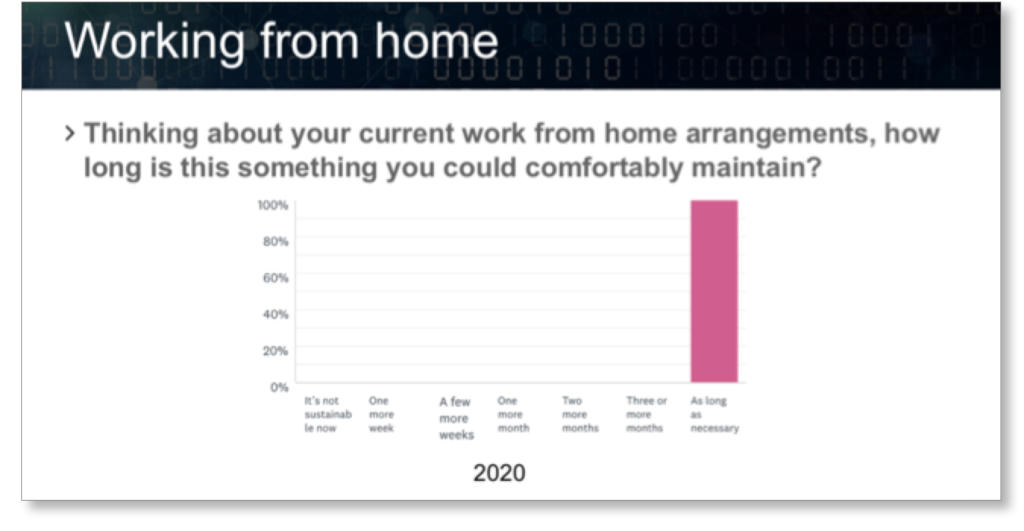
A key part of the picture is that the nature of our work simply allows us to work from home effectively. Many others don’t have that luxury. We’re privileged to be able to work from our homes, and recognize this comes with a responsibility to do so productively, while we also recognize our shared responsibility to observe health and safety guidelines to keep one another safe.
Programmatic Advertising Changes the Landscape for Marketing Success
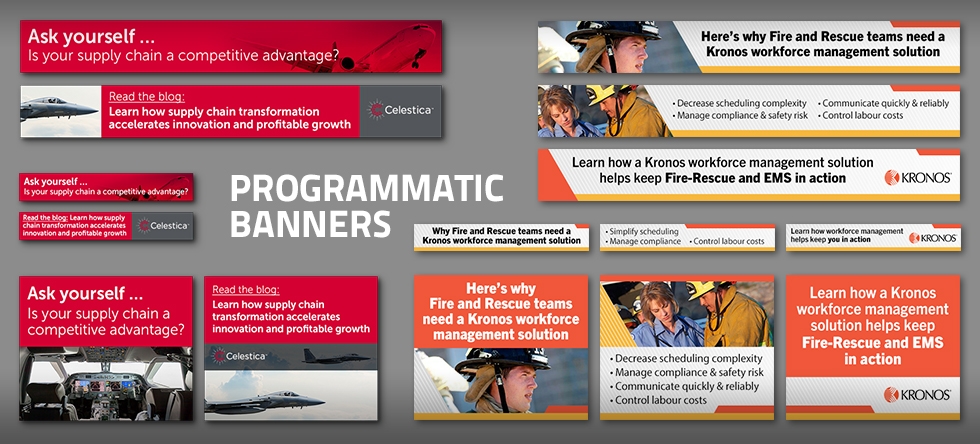
The challenge of any marketer is to identify and reach their audiences as cost-effectively as possible, and influence maximum response. The proliferation of mobile devices has led to an evolution in the rules of engagement for marketers. For example, today, we can reach amazingly closely-targeted audiences anytime, anywhere, deliver a range of creative messages, measure response in many ways, and manage the whole process in real-time.
‘Programmatic’ advertising is an all-encompassing term for the automated form of online display advertising that makes this all possible. It’s particularly effective for:
- Reaching closely-defined audiences
- Establishing presence and awareness among audiences
- Engaging audiences to respond to offers by clicking on the ads
- Targeting audiences based on their location (e.g. in an office building or attending an event)
- Varying messages to appeal to diverse audience segments
- Building frequency by re-targeting people who have received, or clicked on an ad
The most basic and easily achieved objective of programmatic advertising is, quite simply, audience engagement. It is particularly effective in generating broad yet targeted reach to support strategies like establishing presence and awareness. It also facilitates lead generation with its ability to identify and attract closely-targeted audiences and engage them with valuable content.
The programmatic platform is compelling in that it offers so many innovative ways to deliver advertising messages, and serves as the lynchpin of highly-effective content marketing strategies. Content is often the star of the show, in the form of blogs post, videos, whitepapers and much more. Programmatic ads deliver messages enticing viewers to click to a website where the content is available to read or download. Plus, the technology enables re-targeting of those viewers to enhance engagement, and real-time measurement and optimization tactics ensure budgets are maximized for best results.
StrategicAmpersand is a strong proponent of programmatic advertising for one very simple reason – it works! But our clients are the best advocates for this form of ‘smart’ advertising.
Celestica engages with attendees at global trade shows
Celestica, a world leader in high-reliability design, manufacturing and supply chain solutions, uses location-based programmatic advertising to geo-target prospects while they are attending industry trade shows around the world. This exceptionally cost-effective advertising tactic also enables us to re-target the devices attendees used at the shows for ongoing nurturing. Targeting vertical markets like Aerospace & Defense and Smart Energy, the messaging and offers drove prospects to thought leadership content on the company’s website. When an event is over, we optimize ads according to response – non-responders are re-targeted to increase advertising frequency, and those who responded with a click are re-targeted with alternative messaging, all aimed at maximizing engagement. Real time measurement and optimization enables Celestica to split-test creative messages to maximize impact and engagement.
Kronos builds engagement and actionable leads
Kronos, a leading global provider of HR management solutions, sees a consistent rise in both website traffic and actionable leads directly attributed to programmatic advertising. The campaign started with a test of location-based campaigns, but Kronos has expanded their use of programmatic to include an ‘always on’ strategy, which runs concurrent to location-based efforts. The always-on campaign identifies audiences according to traditional criteria (industry, job function, company size, etc.), and contextually through keywords, so display ads appear next to relevant content on diverse yet relevant websites. While Celestica’s priority was presence and awareness, Kronos was interested in generating leads and, as such, was able to test response to gated vs. non-gated landing pages with great results.
Programmatic advertising doesn’t require a big investment to generate engagement, and the transparency it affords allows for easy fine-tuning of variables such as budget, creative and calls-to-action for optimum results.Partnering for PR Success
Find out how Programmatic can support your marketing objectives.
Email: gayle@stratamp.com.

